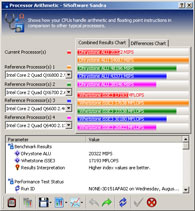Our Test Systems and SANDRA
How we configured our test systems: When configuring our test systems for the following set of benchmarks, we first entered their respective system BIOSes and set each board to its "Optimized" or "High-Performance Defaults." The hard drives were then formatted, and Windows XP Professional (SP2) was installed. When the Windows installation was complete, we installed the drivers necessary for our components, and removed Windows Messenger from the system. Auto-Updating and System Restore were then disabled, and we set up a 1024MB permanent page file on the same partition as the Windows installation. Lastly, we set Windows XP's Visual Effects to "best performance," installed all of our benchmarking software, defragged the hard drives, and ran all of the tests.
|
|
|
|
System 1: AMD Athlon 64 X2 5200+ (2.6GHz) Gigabyte MA69GM-S2H (AMD 690G) 2GB PC24200 DDR2 (2x1GB) Integrated Radeon X1250 On-board Ethernet On-board Audio WD 74GB "Raptor" DD 10,000 RPM SATA Windows XP Pro SP2 AMD Driver 7.7 DirectX 9.0c |
System 2:
AMD Athlon 64 X2 5200+ (2.6GHz) MSI K9AGM2 (AMD 690G) 2GB PC24200 DDR2 (2x1GB) Integrated Radeon X1250 On-board Ethernet On-board Audio WD 74GB "Raptor" DD 10,000 RPM SATA Windows XP Pro SP2 AMD Driver 8.342 DirectX 9.0c |
|
|
|
We started testing with SiSoftware's SANDRA XI, the System ANalyzer, Diagnostic and Reporting Assistant, by running two built-in subsystem tests; CPU Arithmetic and Memory Bandwidth. The memory bandwidth test was run twice, once at DDR2-533 (for comparison with our original article) and once at DDR2-800, the maximum officially supported speed.



SiSoft SANDRA: CPU Arithmetic @ 2.6GHz, Memory @ DDR2-533, Memory @ DDR2-800
SANDRA didn't report any major changes in regard to CPU performance, but the memory bandwidth test conducted at DDR2-533 did show a marked advantage for the updated Gigabyte motherboard we used in the article. When we first looked at the 690-chipset, it managed about 4.9GB/s of bandwidth when using the IGP (results available here). This time around, however, it put up about 5.3GB/s.






